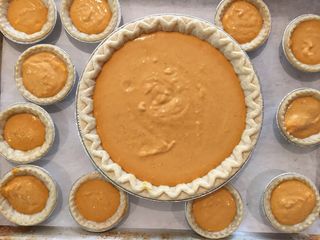Confidence
Save Your Thanksgiving With Multi-Minute Cooking Videos
Ways to increase kitchen confidence without picking up a whisk.
Posted November 18, 2016

Thanksgiving is less than a week away, and I bet most of you are thinking, "What do I do with this 22-pound turkey?!" or "How do I make cranberry sauce?" Perhaps even "What do I feed a vegan?" If you are like most people, the idea of hosting or participating in a large-scale meal event can be very daunting.
I have been an avid home cook for several years. In fact, I think that is one of the reasons my husband sticks around. I can roast, grill, and bake with the best of them. I enjoy good food very much and have an internal passion for providing tasty food. Much of this passion has spilled over into my work as an educational and cognitive psychologist (see my most recent work in this text). However, I have been thrown for a loop over the last several years with some in-family dietary restrictions such as gluten-free, low FODMAP, low-cholesterol living and, well, the ever-changing diet of a growing 4-year-old. Even someone as well versed as myself can have days of under-confidence in the kitchen. Therefore, I look to something that may help unconfident kitchen goers all around.
Part of cooking is to have the feeling that you CAN do the feat. That you ARE able to execute directives from any recipe. Bandura (1986, 1994, 2002) emphasizes that social cognitive theory is used to explain the role of how media shapes the way we think. He indicated that an individual’s behavior is formulated indirectly by viewing models of behavior. "Direct model of behavior? Where do I find such models?" you ask.
So how does this relate to what you have to put in the oven? I have some thoughts and a possible research springboard for any willing social scientist. Vicarious learning is powerful. If you have been checking your Facebook and Instagram feed lately, you will know that there are several "how-to" cooking videos from sites such as Tasty; Cooking Panda, and Goodful. Perhaps you have your own favorite. Perhaps they can provide the viewer with increased self-confidence (or what is called self-efficacy) through vicarious experiences. Let me explain:
Vicarious Experiences. Viewers can learn by observing others, such that vicarious experiences are the typical way human beings interact with their surrounding environment. Bandura (1994) describes modeling as the processes of response acquisition that may have as much impact as direct experience. The ability to use this information or symbols sets humans apart from the limited stimulus-response world of animals (Krenn, 2016). People interpret stimuli, as opposed to just responding to them. We use symbols to understand the world. We are able to regulate and reflect on not only our own actions but in a vicarious sense of the actions of others. Since the availability of media has increased over the years, we are likely to shape our thoughts around what we see in video presentations.
Self-Efficacy. Bandura (1997, 2001) also developed the idea of perceived self-efficacy, defined as our belief in our ability to succeed in specific situations. In this socio-cognitive approach, behavior, cognition, and environmental influences are viewed as commingling constructs of each other (Banudra, 1977, 1986). More specifically, self-efficacy involves the belief that one’s capabilities will successfully prevail over circumstances to achieve a goal. This approach concerns one’s own perceived ability rather than the intention of performing the task. Bandura’s theory thus implies that individuals can exert a semblance of control over their behaviors rather than passively accepting a given situation. Self-efficacy beliefs affect an individual’s behavior and development through their choice of actions in responding to the changing stimuli in an environment.
Feelings of self-efficacy are often correlated with the possession of actual abilities (Bandura, 1997), which is an important determinant of one’s confidence when facing any task. If one knows they have done something well in the past or attempted it this will produce high self-efficacy ratings. These feelings go beyond real ability. Self-efficacy has “effects on thought, affect, action, and motivation” (Bandura, 1997, p. 46). Thus, someone with higher self-efficacy ratings may have more positive goal attainment than someone who has lower self-efficacy ratings, even when both may have the same ability level (Paunonen & Hong, 2010).
How do these positive feelings of self-efficacy arise? For many they are generated during achievements in formal schooling; for example, scoring an excellent grade on a test, knowing the answer when called upon, or witnessing a classmate’s successful equation solving. Observing these models are helpful for overall learning and self-efficacy. Observational learning and modeling are two forms of knowledge acquisition. These two methods are continually utilized when one possess similar information. For this article, most of the presented information also depends on understanding how the “system” of the video program operates.
What makes these multi-minute cooking videos unique?
Processing. The videos are short and simple to process. They also provide steps in a very methodical manner. From start to finish you are presented with visual images of ingredients from gathering to prep. You are also provided with text showing ingredient amounts along with an action (either chopping, stirring, rolling, seasoning, etc.). By pairing information with more than one mode of presentation (i.e. visual images and text), the viewer is able to process this information with much greater ease (Mayer, 2001).
Insert Yourself. Did you ever notice that faces aren't in these videos? You see only hands, right? Think about it: It adds to the experience. When you prepare food, typically one looks down at the counter. In multi-minute videos, the camera is angled down at the counter. You have a visual presentation of a vicarious experience. The video provides the viewer the "feeling" of making the presented dish.
Speed. Ever wonder why the videos are fast? Cooking takes time, and that is one reason why most do not cook as often as they would like (Krenn & Hachey, 2015). Also, when trying to make meals, most are often juggling several tasks at once. The viewer again engages in a vicarious experience, that the process of food preparation can be done with ease as a function of little time. Most people think that cooking is labor intensive by viewing the process as a whole. However, by breaking up the steps and then speeding up the video can provide the view with a feeling a "hey, I can do that!" In other words, it pads our own self-efficacy through vicarious experience, and could, in fact, alter your perspective more positively towards holiday meal prep.
So my advice, for next week: Watch a few videos on these sites. They are a wealth of information that can save you from "lumpy potatoes" or make you "the star of the show" with a tasty dish (who doesn't want to win their in-law's over from time to time). You don't even have to make the dishes offered. Seeing the preparation steps in the uniquely executed format in multi-minute cooking can give you the self-confidence to step into the kitchen... and perhaps not burn it to the ground.
Happy Thanksgiving!
References
Bandura, A. (1977). Social learning theory. New York: General Learning Press.
Bandura, A. (1986). Social foundations of thought and action: A social cognitive theory. Englewood Cliffs, NJ: Prentice-Hall.
Bandura, A. (1994). Social cognitive theory of mass communication. In J. Bryant & D. Zillman (Eds.), Media effects: Advances in theory and research (pp. 61-90). Hillsdale, NJ: Lawrence Erlbaum.
Bandura, A. (1997). Self-efficacy: The exercise of control. New York: Freeman.
Bandura, A. (2001). Guide for constructing self-efficacy scales (Revised). Available from Frank Pajares, Emory University, Atlanta, GA, 30322.
Bandura, A. (2002). Self-efficacy assessment. In R. Fernandez-Ballesteros (Ed.), Encyclopedia of psychological assessment. London: Sage.
Krenn J.L. (2016). Cooking With “App-titude” Suggestions to Help Educators Promote Positive Kitchen Skills With Preschool and Elementary School Students. Handbook of research on mobile learning in contemporary classrooms D. Mentor’s (Ed.) Hershey, PA: IGI Global. doi: 10.4018.978-1-5225-2051-7. http://www.igi-global.com/book/handbook-research-mobile-learning-contem…
Krenn, J. (2015, June 1). He's a Smart Monkey. [Web log post]. Retrieved from https://www.psychologytoday.com/blog/screen-time/201506/here-s-smart-mo…
Krenn, J. & Hachey, A. C. (2015). Cooking with attitude: How preschool children and early primary educators can promote positive lifelong skills in the kitchen. Texas Childcare, 38(4).
Mayer, R. (2001). A cognitive theory of multimedia learning. In R. Mayer (Ed.), Multimedia Learning (pp. 41-62). New York, NY: Cambridge University Press.
Paunonen, S. V., & Hong, R. Y. (2010). Self-efficacy and the prediction of domain-specific cognitive abilities. Journal of Personality, 78(1), 339-359.




